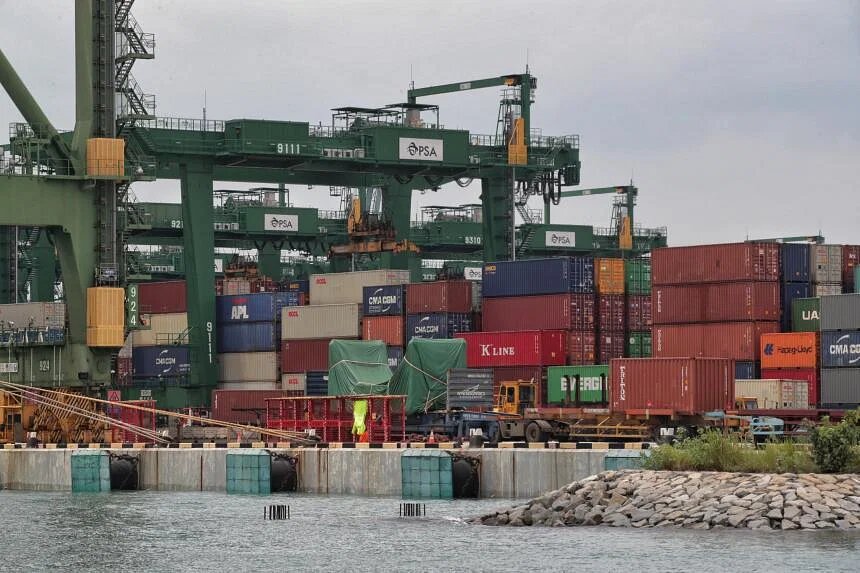
The Republic’s exports have shown no signs of picking up yet, as non-oil domestic exports (Nodx) fell 14.7 per cent in May, from the same month a year ago, worsening from a 9.8 per cent contraction in April and an 8.2 per cent dip in March.
This represents the eighth straight month of contraction for exports since September 2022 when Nodx was up 3.1 per cent.
Similarly, the country’s manufacturing output contracted for an eighth straight month in May, according to figures out earlier this week. It was the first double-digit contraction since November 2019.
The sluggish export performance is raising fears Singapore will slip into a technical recession in the second quarter. The Singapore economy contracted in the first quarter, falling 0.4 per cent from the previous quarter.
The Straits Times examines why Nodx is an important indicator of the country’s economic growth.
Singapore is an open economy and very reliant on external trade as one of its key growth drivers.
The World Bank’s latest data shows exports of goods and services were around 185 per cent of Singapore’s gross domestic product (GDP) in 2021, up from 182 per cent in 2020.
This contrasts with its Asean peers, whose economies are more dependent on domestic demand, with exports making up less than 70 per cent of GDP in 2021 – Malaysia (68.8 per cent), Thailand (58.2 per cent), the Philippines (25.7 per cent) and Indonesia (21.6 per cent).
OCBC Bank’s head of treasury research and strategy Selena Ling said Nodx shows Singapore’s exports to other countries and therefore takes the pulse of external demand and health of the global economy.
“It is a good proxy for generally how our manufacturing and our trade are doing,” she said.
Ms Ling said a lot of products produced in Singapore are not for domestic consumption but for the global markets, so “whatever we produce, we need to be able to sell”.
If overseas demand is weak, it will hurt the manufacturing sector as the country cannot export all the products it makes.
Mr Ong Sin Beng, chief economist for Asean at JP Morgan, said Nodx is a “good barometer of where we are in the goods and industrial production cycle”.
Singapore exports electronics, which include semiconductors and integrated circuits, and non-electronic products like pharmaceuticals and petrochemicals.
Electronics shipments make up around 19 to 21 per cent of Nodx, with non-electronics accounting for the rest.
Enterprise Singapore (EnterpriseSG) said Nodx refers to exports of Singapore origin. These include commodities grown or produced here, and goods which have gone through some transformation – they are manufactured, assembled or processed here.
Goods which have imported materials or parts are also considered in the Nodx figures if they have been manufactured, assembled or processed here.
Non-oil re-exports refer to all goods which are exported from Singapore in the same form as they have been imported without any transformation. There is no value-add by local manufacturers.
Repacking, splitting into lots, sorting and grading are not considered undergoing transformation.
Ms Ling said non-oil re-exports can indicate the health of the external economy.
But the focus is more on Nodx rather than on non-oil re-exports because “Nodx has a closer correlation with manufacturing industry production”.
A technical recession is when the economy posts two consecutive quarters of quarter-on-quarter contraction.
Singapore’s economy shrank 0.4 per cent on a quarter-on-quarter basis in the first quarter of 2023.
There are fears it will shrink again in the second quarter.
The last time the country slipped into a technical recession was in the second quarter of 2020 when it contracted by 42.9 per cent compared with the previous quarter, after contracting 3.1 per cent in the first quarter of 2020.
“The Nodx numbers have been very weak of late. It is a reflection that the global economy is slowing down and demand is slow,” said Ms Ling.
While a technical recession cannot be ruled out, she added that the full-year prognosis “should still be for around 1.5 per cent year-on-year growth”.
The official forecast is for 0.5 to 2.5 per cent expansion for the whole of 2023.
“Full-year 2023 compared to 2022, the economy can still grow, but if you look at the four quarters within 2023, growth could be slowing in the first and second quarters, and maybe there is a pick-up in the second half,” she said.
Source: ST Straits Times
Share: